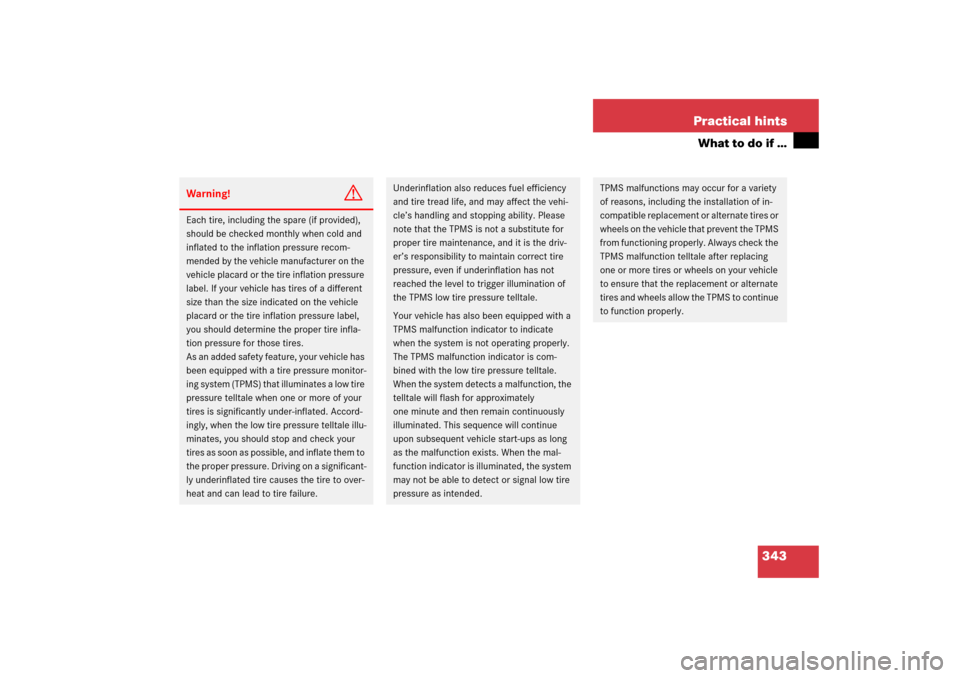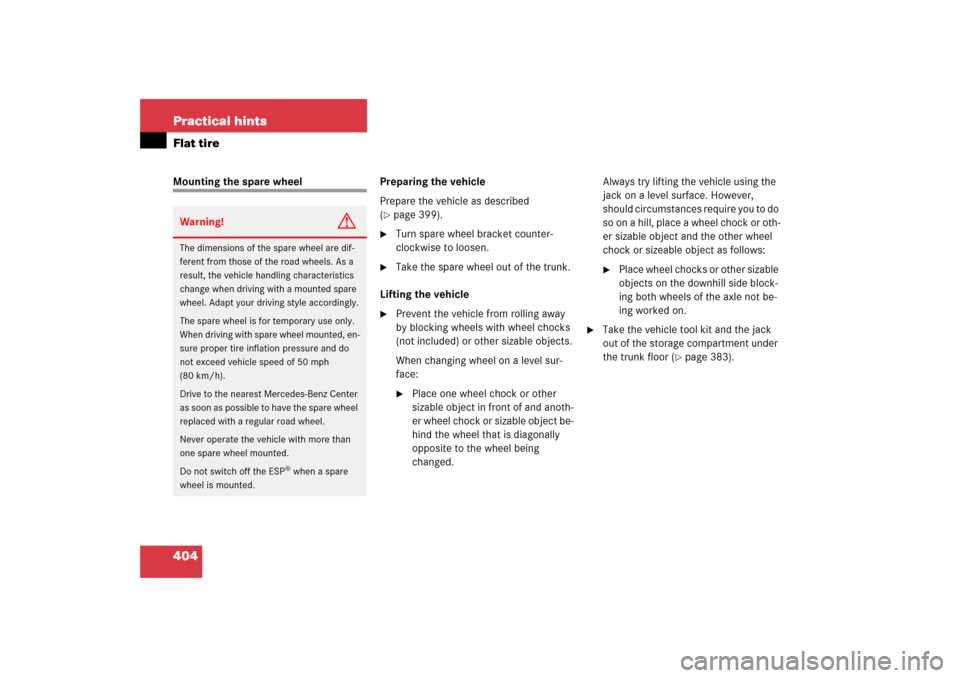Page 318 of 480

317 Operation
Winter driving
Snow chains
Snow chains should only be driven on
snow-covered roads at speeds not to ex-
ceed 30 mph (50 km/h). Remove chains
as soon as possible when driving on roads
without snow. Please observe the following guidelines
when using snow chains:
�
Use of snow chains is not permissible
with all wheel/tire combinations.
�
Snow chains should only be used on
the rear wheels. Follow the manufac-
turer's mounting instructions.
�
Only use snow chains that are ap-
proved by Mercedes-Benz. Your autho-
rized Mercedes-Benz Center will be
glad to advise you on this subject.
�
Use of snow chains may be prohibited
depending on location. Always check
local and state laws before installing
snow chains.
!When driving with snow chains, always
select setting 1 of the level control sys-
tem (
�page 220). Other settings may
result in damage to your vehicle.
iWhen driving with snow chains, you
may wish to deactivate the ESP
®
(
�page 86) before setting the vehicle
in motion. This will improve the vehi-
cle’s traction.
!Some tire sizes do not leave adequate
clearance for snow chains. To help
avoid serious damage to your vehicle or
tires, use of snow chains is not permis-
sible with the spare wheel and with tire
size:�
285/35 R18 97W
�
285/35 R18 97Y
�
285/35 ZR18 97Y
�
285/35 R18 97Y MOExtended
�
285/35 R18 97V M+S .
MOExtended
�
285/30 ZR19 98Y XL (Extra Load)
Page 344 of 480

343 Practical hints
What to do if …
Warning!
G
Each tire, including the spare (if provided),
should be checked monthly when cold and
inflated to the inflation pressure recom-
mended by the vehicle manufacturer on the
vehicle placard or the tire inflation pressure
label. If your vehicle has tires of a different
size than the size indicated on the vehicle
placard or the tire inflation pressure label,
you should determine the proper tire infla-
tion pressure for those tires.
As an added safety feature, your vehicle has
been equipped with a tire pressure monitor-
ing system (TPMS) that illuminates a low tire
pressure telltale when one or more of your
tires is significantly under-inflated. Accord-
ingly, when the low tire pressure telltale illu-
minates, you should stop and check your
tires as soon as possible, and inflate them to
the proper pressure. Driving on a significant-
ly underinflated tire causes the tire to over-
heat and can lead to tire failure.
Underinflation also reduces fuel efficiency
and tire tread life, and may affect the vehi-
cle’s handling and stopping ability. Please
note that the TPMS is not a substitute for
proper tire maintenance, and it is the driv-
er’s responsibility to maintain correct tire
pressure, even if underinflation has not
reached the level to trigger illumination of
the TPMS low tire pressure telltale.
Your vehicle has also been equipped with a
TPMS malfunction indicator to indicate
when the system is not operating properly.
The TPMS malfunction indicator is com-
bined with the low tire pressure telltale.
When the system detects a malfunction, the
telltale will flash for approximately
one minute and then remain continuously
illuminated. This sequence will continue
upon subsequent vehicle start-ups as long
as the malfunction exists. When the mal-
function indicator is illuminated, the system
may not be able to detect or signal low tire
pressure as intended.
TPMS malfunctions may occur for a variety
of reasons, including the installation of in-
compatible replacement or alternate tires or
wheels on the vehicle that prevent the TPMS
from functioning properly. Always check the
TPMS malfunction telltale after replacing
one or more tires or wheels on your vehicle
to ensure that the replacement or alternate
tires and wheels allow the TPMS to continue
to function properly.
Page 405 of 480

404 Practical hintsFlat tireMounting the spare wheel Preparing the vehicle
Prepare the vehicle as described
(
�page 399).
�
Turn spare wheel bracket counter-
clockwise to loosen.
�
Take the spare wheel out of the trunk.
Lifting the vehicle
�
Prevent the vehicle from rolling away
by blocking wheels with wheel chocks
(not included) or other sizable objects.
When changing wheel on a level sur-
face:�
Place one wheel chock or other
sizable object in front of and anoth-
er wheel chock or sizable object be-
hind the wheel that is diagonally
opposite to the wheel being
changed.Always try lifting the vehicle using the
jack on a level surface. However,
should circumstances require you to do
so on a hill, place a wheel chock or oth-
er sizable object and the other wheel
chock or sizeable object as follows:
�
Place wheel chocks or other sizable
objects on the downhill side block-
ing both wheels of the axle not be-
ing worked on.
�
Take the vehicle tool kit and the jack
out of the storage compartment under
the trunk floor (
�page 383).
Warning!
G
The dimensions of the spare wheel are dif-
ferent from those of the road wheels. As a
result, the vehicle handling characteristics
change when driving with a mounted spare
wheel. Adapt your driving style accordingly.
The spare wheel is for temporary use only.
When driving with spare wheel mounted, en-
sure proper tire inflation pressure and do
not exceed vehicle speed of 50 mph
(80 km/h).
Drive to the nearest Mercedes-Benz Center
as soon as possible to have the spare wheel
replaced with a regular road wheel.
Never operate the vehicle with more than
one spare wheel mounted.
Do not switch off the ESP
® when a spare
wheel is mounted.
Page 436 of 480

435 Technical data
Rims and tires
iFurther information on tires and rims is
available at any authorized
Mercedes-Benz Center. A placard with
the recommended tire inflation pres-
sures is located on the driver’s door
B-pillar. Some vehicles may have sup-
plemental tire inflation pressure infor-
mation for driving at high speeds
(�page 292) or for vehicle loads less
than the maximum loaded vehicle con-
dition (
�page 292). If such information
is provided, it can be found on the plac-
ard located on the inside of the fuel fill-
er flap. The tire inflation pressure
should be checked regularly and
should only be adjusted on cold tires.
Follow tire manufacturer’s mainte-
nance recommendation included with
vehicle.
iThe following pages also list the ap-
proved wheel rim and tire sizes for
equipping your vehicles with winter
tires. Winter tires are not available as
standard or optional factory equip-
ment, but can be purchased from an
authorized Mercedes-Benz Center.
Depending on vehicle model and the
standard or optional factory-equipped
wheel rim/tire configuration on your
vehicle (Performance Package, Sport
Package etc.), equipping your vehicle
with winter tires approved for your ve-
hicle model may also require the pur-
chase of two or four wheel rims of the
recommended size for use with these
winter tires. See an authorized
Mercedes-Benz Center for more infor-
mation.
Page 437 of 480
436 Technical dataRims and tiresSame size tires
17" tires
18" tires
SL 500* (Canada only)
Rims (light alloy)
8.5 J x 17 H2
Wheel offset
1.38 in (35 mm)
Summer tires
1
1Radial-ply tires
255/45 R17 98W
Winter tires
1,2
2Not available as factory equipment.
255/45 R17 98V M+S .SL 500
SL 600
SL 55 AMG
Rims (light alloy)
8.5 J x 18 H2
8.5 J x 18 H2
8.5 J x 18 H2
Wheel offset
1.38 in (35 mm)
1.38 in (35 mm)
1.18 in (30 mm)
Summer tires
1
1Radial-ply tires
-
-
-
Winter tires
1,2
2Not available as factory equipment.
255/40 R18 95V M+S .
255/40 R18 95V M+S .
255/40 R18 95V M+S .
Page 439 of 480
438 Technical dataRims and tiresMixed size tires
SL 500
SL 500 (Sport Package*)
SL 600
SL 600 (Sport Package*)
Front axle:
Rims (light alloy)
8.5 J x 18 H2
8.5 J x 18 H2
8.5 J x 18 H2
Wheel offset
1.38 in (35 mm)
1.38 in (35 mm)
1.38 in (35 mm)
Summer tires
1
1Radial-ply tires
255/40 R18 95W
255/40 R18 95Y
255/40 ZR18 95Y
Rear axle:
Rims (light alloy)
9.5 J x 18 H2
9.5 J x 18 H2
9.5 J x 18 H2
Wheel offset
1.57 in (40 mm)
1.57 in (40 mm)
1.57 in (40 mm)
Summer tires
1,2
2Must not be used with snow chains.
285/35 R18 97W
285/35 R18 97Y
285/35 ZR18 97Y
Page:
< prev 1-8 9-16 17-24